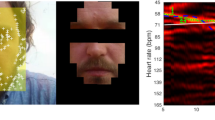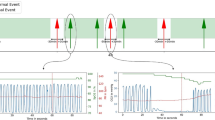Abstract
The reflection mode photoplethysmographic (PPG) signal was studied with the aim of determining respiratory rate. The PPG signal includes respiratory synchronous components, seen as frequency modulation of the heart rate (respiratory sinus arrhythmia), amplitude modulation of the cardiac pulse and respiratory-induced intensity variations (RIIVs) in the PPG baseline. PPG signals were recorded from the foreheads of 15 healthy subjects. From these signals, the systolic wavefrm diastolic waveform, respiratory sinus arrhythmia, pulse amplitude and RIIVs were extracted. Using basic algorithms, the rates of false positive and false negative detection of breaths were calculated separately for each of the five components. Furthermore, a neural network was assessed in a combined pattern recognition approach. The error rates (sum of false positive and false negative breath detections) for the basic algorithms ranged from 9.7% (pulse amplitude) to 14.5% (systolic waveform). The corresponding values for the neural network analysis were 9.5–9.6%. These results suggest the use of a combined PPG system for simultaneous monitoring of respiratory rate and arterial oxygen saturation (pulse oximetry).
Similar content being viewed by others
References
Allen, J., andMurray, A. (1993): ‘Development of a neural network screening aid for diagnosing lower limb peripheral vascular disease from photoelectric plethysmography pulse waveforms’,Physiol. Meas.,14, pp. 13–22
Aoyagi, T., Kishi, M., Yamaguchi, K., andWatanable, S. (1974): ‘Improvement of the earpiece oximeter’,Proc. 13th Ann. Meet. Japanese Soc. Med. Electron. Biol. Eng.
Bishop, C. M. (1995): ‘Neural networks for pattern recognition’, (Oxford University Press, Oxford, 1995).
Buda, A. J., Pinsky, M. R., Ingels, N. B., Daughters, G. T., Stinson, E. B., andAlderman, E. L. (1979): ‘Effect of intrathoracic pressure on left ventricular performance’,N. Engl. J. Med.,301, pp. 453–459.
Challoner, A. V. J. (1979): ‘Photoelectric plethysmography for estimating cutaneous blood flow’, inRolfe, P. (Ed.): ‘Non-invasive physiological measurements’, (Academic Press, London, 1979), pp. 125–151.
Dorlas, J. C., andNijboer, J. A. (1985): ‘Photo-electric plethysmography as a monitoring device in anaesthesia’,Br. J. Anaesth.,57, pp. 524–530.
Dornhorst, A. C., Howard, P., andLeathart, G. L. (1952): ‘Respiratory variations in blood pressure’,Circulation,6, pp. 553–558.
Eldrup-Jorgensen, S., Schwartz, A. I., andWallace, J. D. (1966): ‘A method for clinical evaluation of peripheral circulation: photoelectric hemodensitometry’,Surgery,59, pp. 505–513
Gilbert, R., Auchincloss, J. H., Brodsky, J., andBoden, W. (1972): ‘Changes in tidal volume, frequency, and ventilation induced by their measurement’,J. Appl. Physiol.,33, pp. 252–254
Johansson, A., andÖberg, P. Å (1999a): ‘Estimation of respiratory volumes from the photoplethysmographic signal-Part I: experimental results’,Med. Biol. Eng. Comput.,37, pp. 42–47
Johansson, A., andÖberg, P. Å. (1999b): ‘Estimation of respiratory-volumes from the photoplethysmographic signal-Part II: a model study’,Med. Biol. Eng. Comput.,37, pp. 48–53
Johansson, A., Öberg, P. Å., andSedin, G. (1999): ‘Monitoring of heart and respiratory rates in newborn infants using a new photoplethysmographic technique’,J. Clin. Monit.,15, pp. 461–467
Kamath, M. V., andFallen, E. L. (1993): ‘Power spectral analysis of heart rate variability: a nonivasive signature of cardiac autonomic function’,Crit. Rev. Biomed. Eng.,21, pp. 245–311
Leon, M. A., andLorini, F. L. (1997): ‘Ventilation mode recognition using artificial neural networks’,Comput. Biomed. Res.,30, pp. 373–378
Lindberg, L.-G., Ugnell, H., andÖberg, P. Å. (1992): ‘Monitoring of respiratory and heart rates using a fibre-optic sensor’,Med. Biol. Eng. Comput.,30, pp. 533–537
Mendelson, Y. (1992): ‘Pulse oximetry: Theory and applications for noninvasive monitoring’,Clin. Chem.,38, pp. 1601–1607
Nijboer, J. A., andDorlas, J. C. (1982): ‘The origin of inverted waveforms in the reflection plethysmogram’,Br. J. Anaesth.,54, pp. 1289–1293
Nilsson, L., Johansson, A., andKalman, S. (2000): ‘Monitoring of respiratory rates in postoperative care using a new photoplethysmographic technique’,J. Clin. Monit. Comput.,16, pp. 309–315.
Sittig, D. F., andOrr, J. A. (1992): ‘A parallel implementation of the backward error propagation neural network training algorithm: experiments in event identification’,Comput. Biomed. Res.,25, pp. 547–561
Tremper, K. K., andBarker, S. J. (1989): ‘Pulse oximetry’,Anesthesiology,70, pp. 98–108
Tur, E., Tur, M., Maibach, H. I., andGuy, R. H. (1983): ‘Basal perfusion of the cutaneous microcirculation: Measurements as a function of anatomic position’,J. Investigat. Dermatol.,81, pp. 442–446
Ugnell, H. (1996): ‘The respiratory synchronous photoplethysmographic signal. Its dependence on light wavelength and sample volume’,Med. Biol. Eng. Comput.,34, pp. 275–276
Vegfors, M., Lindberg, L.-G., Pettersson, H., andÖberg, P. Å. (1994): ‘Presentation and evaluation of a new optical sensor for respiratory rate monitoring’,Int. J. Clin. Mon. Comput.,11, pp. 151–156
Watrous, R., andTowell, G. (1995): ‘A patient-adaptive neural network ECG patient monitoring algorithm’, in ‘Computers in cardiology’, (IEEE, Cat. No. 95CH35874, New York, 1995), pp. 229–232
Wilks, P. A. D., andEnglish, M. J. A. (1995): ‘A system for rapid identification of respiratory abnormalities using a neural network’,Med. Eng. Phys.,17, pp. 551–555
Ziege, S., Schmid-Schönbein, H., Grebe, R., andMartin, E. (1997): ‘Long-term registration of cutaneous microcirculation during general anaesthesia’,Int. J. Microcirc.,17, pp. 385–394
Author information
Authors and Affiliations
Corresponding author
Rights and permissions
About this article
Cite this article
Johansson, A. Neural network for photoplethysmographic respiratory rate monitoring. Med. Biol. Eng. Comput. 41, 242–248 (2003). https://doi.org/10.1007/BF02348427
Received:
Accepted:
Issue Date:
DOI: https://doi.org/10.1007/BF02348427




